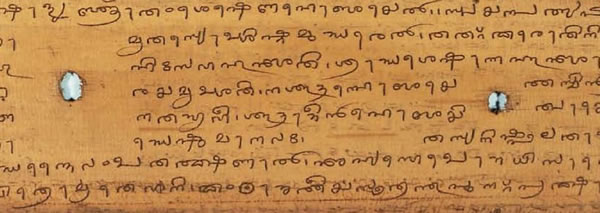The Tigalari alphabet developed from the Grantha alphabet in the 12th century AD. It was used to to write Sanskrit at first, and from the 15th century it was also used to write Tulu. There are also texts in Kannada written in the Tigalari alphabet.
The Tigalari alphabet was used mainly for religious writings in Tulu, and is still used to some extent in parts of Kanara region of Karnataka. For other purposes Tulu speakers use the Kannada alphabet.
Recently there have been efforts to revive the use of the Tigalari script for Tulu, and it is taught in schools in the Mangalore and Udupi districts of Karnataka.
Tigalari is also known as the Tulu script, Tulu Grantha script, Arya Ezhuttu, Grantha Malayalam, Western Grantha, Tulu-Malayalam, Tulu Lipi or Tulu Grantha Lipi.

Download an alphabet chart for Tigalari (Excel)

Source: https://commons.wikimedia.org/wiki/File:Tigalari-sanskrit-manuscript.jpg
Information about the Tigalari alphabet
https://en.wikipedia.org/wiki/Tigalari_script
http://shivallibrahmins.com/tulu-language/tulu-language-and-script/
https://www.unicode.org/L2/L2020/20279-tulu-tigalari-cmts.pdf
https://tigalari.blogspot.com/
https://tulu-research.blogspot.com/2016/03/357-tigalari-tulu-script.html
http://www.unicode.org/L2/L2017/17378-tigalari.pdf
https://www.facebook.com/Tigalari/
Ahom, Aima, Arleng, Badagu, Badlit, Basahan, Balinese, Balti-A, Balti-B, Batak, Baybayin, Bengali, Bhaiksuki, Bhujimol, Bilang-bilang, Bima, Blackfoot, Brahmi, Buhid, Burmese, Carrier, Chakma, Cham, Cree, Dehong Dai, Devanagari, Dham Lipi, Dhankari / Sirmauri, Ditema, Dives Akuru, Dogra, Ethiopic, Evēla Akuru, Fox, Fraser, Gond, Goykanadi, Grantha, Gujarati, Gunjala Gondi, Gupta, Gurmukhi, Halbi Lipi, Hanifi, Hanuno'o, Hočąk, Ibalnan, Incung, Inuktitut, Jaunsari Takri, Javanese, Kaithi, Kadamba, Kamarupi, Kannada, Kawi, Kharosthi, Khema, Khe Prih, Khmer, Khojki, Khudabadi, Kirat Rai, Kōchi, Kodava Lipi, Komering, Kulitan, Kurukh Banna, Lampung, Lanna, Lao, Lepcha, Limbu, Lontara/Makasar, Lota Ende, Magar Akkha, Mahajani, Malayalam, Meitei (Modern), Manpuri (Old), Marchen, Meetei Yelhou Mayek, Meroïtic, Masarm Gondi, Modi, Mon, Mongolian Horizontal Square Script, Multani, Nandinagari, Newa, New Tai Lue, Ojibwe, Odia, Ogan, Pahawh Hmong, Pallava, Phags-pa, Purva Licchavi, Qiang / Rma, Ranjana, Rejang (Kaganga), Sasak, Savara, Satera Jontal, Shan, Sharda, Sheek Bakrii Saphaloo, Siddham, Sinhala, Sorang Sompeng, Sourashtra, Soyombo, Sukhothai, Sundanese, Syloti Nagri, Tagbanwa, Tai Noi, Takri, Tamil, Tanchangya (Ka-Pat), Tani, Thaana, Telugu, Thai, Tibetan, Tigalari, Tikamuli, Tocharian, Tolong Siki, Vatteluttu, Warang Citi
Page last modified: 16.03.23
[top]
You can support this site by Buying Me A Coffee, and if you like what you see on this page, you can use the buttons below to share it with people you know.

If you like this site and find it useful, you can support it by making a donation via PayPal or Patreon, or by contributing in other ways. Omniglot is how I make my living.
Note: all links on this site to Amazon.com, Amazon.co.uk
and Amazon.fr
are affiliate links. This means I earn a commission if you click on any of them and buy something. So by clicking on these links you can help to support this site.
[top]